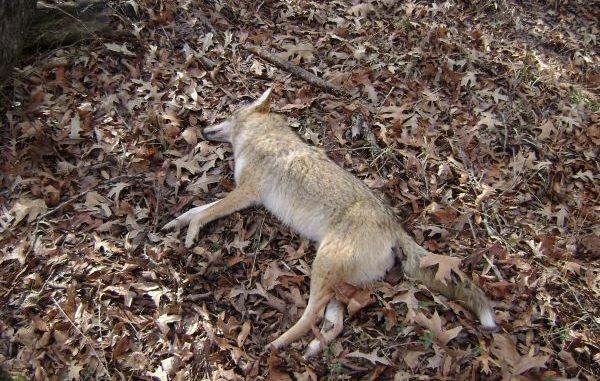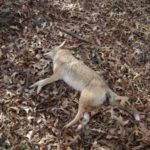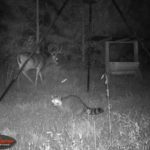
In early September, a hog hunter buddy of mine was out one morning on a private hunting lease. He and another hunter were there to hunt hogs the leaseholders wanted removed from the property.
This friend had a young dog that was learning fast and showing signs of becoming a good hog dog.
Both hunters cast their dogs and rode through the property on ATVs while the dogs roamed the woods searching for hogs. As the morning wore on, the dogs covered quite a bit of territory.
They might have cold-trailed one or more hogs as they hunted, but they never actually brought any to bay.
My friend’s young dog finally returned to him and was loaded on the ATV. Shortly thereafter, both men noticed the dog was not acting normal.
It seemed overly tired and sat or laid down on the ATV, something this energetic young dog never did. Before long it was obvious the dog was very sick, and its condition continued to deteriorate.
I will spare you the details, but within four hours the dog was dead.
It was later determined the cause of death was ingested poison.
It is not clear whether the dog found poisoned bait and ate it or came across the carcass of a poisoned animal and picked it up secondhand.
Either way, the result was the same — and, unfortunately, it was neither surprising nor anything new.
More than 50 years ago, my dad had a similar experience while hunting rabbits with beagles along the levee on Red River. Two dogs were lost to what he suspected was strychnine set out for coyotes.
The use of poison in North America can be traced all the way back to the arrival of the earliest settlers, who apparently brought the practice with them from Europe.
Large predators such as wolves and bears were the primary targets.
A. B. Guthrie Jr., who wrote several novels about life and adventure in the American West, included stories of poisoning. In one of his novels the main character made a living as a “wolfer,” placing strychnine in buffalo carcasses left by buffalo hunters, and then skinning the poisoned wolves that fed on the carcasses.
What a lovely way to make a living.
Interestingly, Guthrie mentioned that Indians hated the wolfers more than other whites because the strychnine poisoned their dogs.
Similar stories have come from places such as Alaska and Canada, where valuable sled dogs were lost to poison set out for wolves and foxes.
Here in Louisiana and throughout the Southeast, use of poison (and reports of its use) has been on the increase over the last 20 years or more. Some speculate that as fur trapping has drastically declined and nuisance or predator species numbers have increased, poisoning has become the very ugly and illegal answer.
In some cases, the target species is specific.
The best current example is the feral hog.
In spite of its illegality, hog poisoning would probably be more widespread if not for the fact that bait grain used to deliver poison to hogs is readily consumed by deer, as well.
But I suspect those who are poisoning hogs don’t care if deer are lost in the process.
Research is underway to develop toxins to which only hogs are susceptible. Such a product would, no doubt, be fast tracked to market — they would be relatively harmless to other animals and legal.
Another critter currently at the top of the hit list is the raccoon. Raccoons seem to be abundant right now, based on the number of sightings and road kills.
They love corn, and they don’t differentiate “deer corn” from regular corn. So they spend a lot of time around deer feeders figuring out ways to extract corn from the feeder.
This gets them in trouble with a lot of people, who don’t want anything eating the “deer corn” except, of course, deer.
Poison is the answer for many of these folks, and one of the more-popular toxic solutions calls for mixing a particular pelletized insecticide and cola or some other sweet liquid.
The concoction is then placed by the deer feeder. Word is it drops a raccoon in his tracks.
My question is how does one know if deer aren’t eating the stuff right along with the raccoons? Would it not follow that, since the deer is bigger, it might leave the location and go to cover or water before succumbing to the toxin?
The same goes for skunks, possums, rabbits, coyotes and anything else that eats corn — which includes, well, everything. It’s a little difficult to understand why anyone would place a top food choice for all sorts of wildlife in the woods but get angry when they all show up for the buffet.
It is no surprise that use of poison frequently results in the death of non-target animals, and it is hard to believe how quickly and foolishly some people will resort to its use without thought to the possible consequences.
I recall one case that came to light when a wildlife agent was summoned to investigate three dead deer lying in a suburban backyard. The agent got the call from a neighbor who could see the deer from next door.
Upon walking over to investigate, the agent found a bird feeder hanging from a tree limb. Under the feeder he found rat poison, along with the dead doe and her two yearlings.
The agent interviewed the homeowner and eventually got him to admit placing the rat poison under the bird feeder.
His reason? He wanted to eliminate squirrels seen eating the birdseed. It did not occur to him that deer were also eating the fallen seed.
The homeowner was cited for killing the deer and illegal use of a pesticide.
In a 2011 case here in Louisiana, a West Monroe man put out bait laced with a deadly agricultural pesticide. He managed to kill a stunning array of wildlife.
Agents found 54 dead animals, including 17 coyotes, 16 raccoons, 12 possums, four bobcats, a red tailed hawk, a barred owl and two sparrows.
This very lethal pesticide potentially also threatened any unsuspecting humans who might have handled the sick or dead animals.
The man entered a guilty plea in U. S. District Court to charges of violating federal pesticide laws and the Migratory Bird Treaty Act. He was fined $5,000 and placed on probation for three years, including six months of house arrest.
Louisiana Department of Wildlife and Fisheries wildlife enforcement agents and Louisiana Department of Agriculture and Forestry forestry enforcement agents investigate the killing of wildlife by the misuse of pesticides.
Hunters need to be aware of the environmental and ecological impact of these crimes. As one of my friends at LDAF put it: “Most (hunters) would be shocked by the sheer numbers of non-targeted animals killed and the indiscriminate carnage left behind.”
Well said.
Poison is not the answer to managing wildlife problems — real or imaginary. Contact LDWF and speak with one of the wildlife biologists. He or she will be happy to provide information on methods, resources and publications for legal and effective ways to deal with nuisance wildlife.
And, by all means, report cases of suspected poisoning and any other wildlife violations immediately 24 hours a day, seven days a week by calling 800-442-2511.




